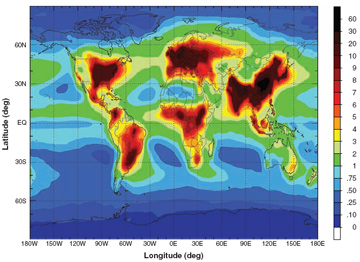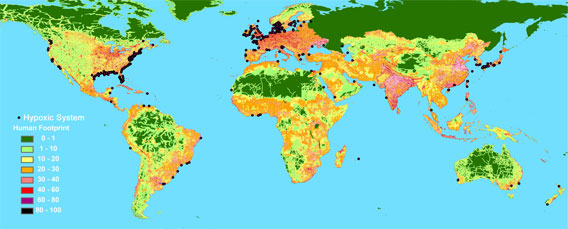Dead zones are caused by agricultural runoff, especially nitrogen-rich fertilizers, and the burning of fossil fuels. The pollutants cause marine eutrophication, whereby the ecosystem receives too many nutrients, triggering massive algae blooms, which eventually die and are broken down bacteria. By breaking down the algae the bacteria consume excessive amounts of oxygen, essentially starving the marine system.
 Estimated N deposition from global total N (NOy and NHx) emissions, totaling 105 Tg N per year. Image appeared in J.N. Galloway et al (2008). “Transformation of the Nitrogen Cycle: Recent Trends, Questions, and Potential Solutions,” Science 16 May 2008. |
The majority of dead zones are near large populations in wealthy nations. For example, the United States’ east coast is covered with hypoxia sites, as is much of western and northern Europe. Such areas—heavy in industry, fishing, and runoffs from intensive agriculture—spew massive amounts of nutrient-rich pollutants into the sea.
The authors note that “most of these systems were not hypoxic when first studied, but it appears that from the middle of the past century, the dissolved oxygen concentrations of many coastal ecosystems have been adversely affected by eutrophication.” A number of human-related factors likely caused the sudden explosion of dead zones, but certainly the development in the 1940s of mass-produced fertilizer containing nitrogen is a major culprit.
Dead zones live up to their name in terms of biomass, the loss of which adds greater strains on already overfished and overexploited oceans. As an example, the researchers note that the Kattegat sea—between Denmark and Sweden—has experienced high levels of fish mortality and a collapse of their lobster industry due to eutrophication. In addition, they estimate that if the entire Baltic Sea recovered from eutrophication it would be one-third to one-half more productive—a boon for Scandinavian fishermen and a reprieve from other fishing areas.
 Global distribution of the 400+ marine systems with dead zones caused by increased eutrophication. Their distribution matches the current human “footprint” in the northern hemisphere. In the southern hemisphere, dead zones have only been reported recently. [Image courtesy of Science/AAAS] |
